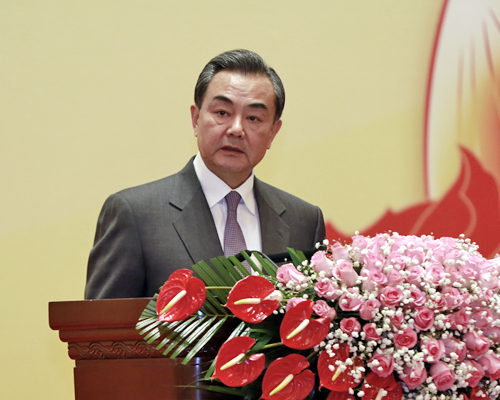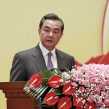
China’s Foreign Policy in 2014: A Year to Harvest Partnerships and the Silk Road
Publication: China Brief Volume: 14 Issue: 24
By:

On December 11, Chinese Foreign Minister Wang Yi gave his annual speech encapsulating China’s foreign policy successes over the last year (Ministry of Foreign Affairs, December 11). He highlighted China’s growing role in the global economy, its economic outreach through new multilateral institutions, peripheral diplomacy and looked ahead to 2015. Most importantly, Wang adopted a softer tone than his 2013 speech, dialing back China’s nationalistic rhetoric and signaling that China is slowly but haltingly working to repair ties with Japan and other neighbors, yet still determined to pressure the United States in Asia.
Calling 2014 a “year to harvest China’s comprehensive diplomatic progress,” Minister Wang detailed China’s growing partnerships around the world. He explained that China has now established partnerships with 67 countries and five regional organizations, but asserted that they are based on “the new interpretation of major power diplomacy with Chinese characteristics”—“forming partnerships but not forming alliances.” Wang also restated President Xi’s call for an “Asian security concept,” including it alongside the Asia Pacific Economic Cooperation (APEC) Connectivity Blueprint as results from the two major conferences China hosted this year. This distinction between partnerships and alliances comes at a time when China is increasingly criticizing the U.S. alliance system in Asia as “Cold War thinking” and aimed at containing China, even earning forceful responses over the last month from Dr. Evan Medeiros, senior director for Asian affairs of the National Security Council, and Daniel Russel, Assistant Secretary of State for East Asian and Pacific Affairs (Beijing News, June 6; Global Times, December 9). Chinese officials and media will likely continue to hone in on U.S. alliances in 2015 as maritime tensions rise with U.S. allies.
President Xi’s efforts this year to promote the “one belt and one road,” better known as the “Silk Road Economic Belt” and “21st Century Maritime Silk Road,” also featured prominently. Wang touted the 50 countries that have agreed to participate and the creation of the $40 billion Silk Road Fund that is intended to support the initiative, along with the more general $50 billion Asia Infrastructure Investment Bank (AIIB) (Xinhua, November 8). This emphasis compliments a year-end diplomatic push in Beijing, as over 60 foreign embassies visited the National Museum of China’s new exhibit on the Silk Road on December 15 (Xinhua, December 15). Xinhua later said that “if 2013 was the year that the ‘one belt, one road’ strategic concept was unveiled, then 2014 was the year that it really entered the stage of practical cooperation” (Xinhua, December 17). Wang also noted that China’s economic growth represented a “contribution rate” of 27.8 percent to global growth and more than 50 percent to Asia. Echoing Xi, Wang said China’s economy had entered a “new normal” of slower growth but added that China’s continued growth in the face of a depressed global economy presented a “China opportunity” to the world. Clearly, Wang and the Chinese leadership see China’s growing economy as its greatest foreign policy asset for improving relations with partners around the world through its new Silk Road initiative.
Minister Wang also toned down his criticism of Japan and eliminated discussions about maritime issues when compared to his 2013 speech (Guangming Daily, January 11). In last year’s speech, Wang said “China would unswervingly walk the road of peaceful development, but certainly not at the price of sacrificing China’s national interests” and noted that Beijing would “strongly restrain” Japan and the Philippines from “invading China’s sovereign territory” (Guangming Daily, January 11). Yet Wang’s 2014 speech never mentioned the South China Sea or the Philippines, and only noted that 2015 will be the 70th anniversary of China’s victory in the “War to Resist Japan,” China’s name for their 1937–1945 war. This came just two days before President Xi visited the Nanjing Massacre Museum to commemorate China’s first National Memorial Day (Xinhua, December 13). Several Chinese analysts pointed out that Xi’s statement was much more conciliatory than previous remarks before he met Japanese Minister Shinzo Abe at APEC: “We should not bear hatred against an entire nation just because a small minority of militarists launched aggressive wars. The responsibilities for war crimes lie with a few militarists, but not the people. However, we cannot at any time forget the severe crimes committed by aggressors” (Author’s interview, December 15; Xinhua, December 13). The looming question for 2015 is whether China’s softer rhetoric will be sustained, and more importantly, if it will be accompanied by a real reduction of tensions along its disputed maritime borders.
Minister Wang closed his speech by restating President Xi’s vision for the realization of the “great dream of the revival of the Chinese people” and the “beautiful dream” of the world. This continues Xi’s campaign to expand the “China Dream” beyond its borders, evident in his call at APEC for an “Asia-Pacific Dream,” the first time he had used the phrase (People’s Daily Online, November 9).





